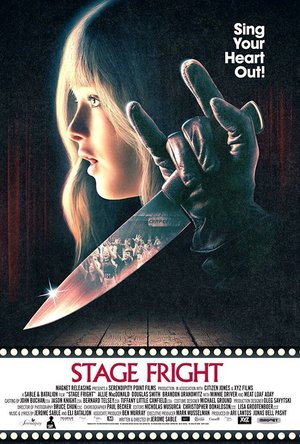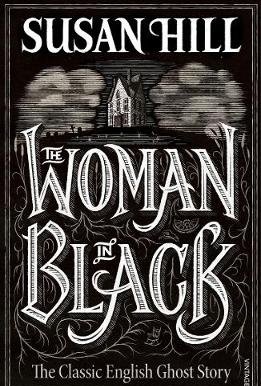Search

Stage Fright (2014)
Movie
A starry-eyed teenager stuck in the kitchen of a snobby performing arts camp dreams of Broadway. She...

Black Water Lilies: A Novel
Shaun Whiteside and Michel Bussi
Book
'Ends with one of the most reverberating shocks in modern crime fiction' Sunday Times This is the...
Hadley (567 KP) rated The Woman in Black in Books
Jan 1, 2020
Great paranormal aspect (1 more)
Good narrative
Overuse of some words (1 more)
Some scenes that could have been written better
In Susan Hill's novel, "The Woman in Black," she puts a small twist on an urban legend that is widely known to most - - - 'the lady in white,' which if you haven't heard of it, it's a spectral woman that is seen throughout the world, dressed all in white, only to show up in places of tragic events. This novel only has one main character, Arthur Kipps, a 23-year-old young man who is a lawyer in late 1800's England. He usually takes care of the conveyance of property leases, but one day, when his boss, Mr. Bentley, hands over a case and responsibility of finding a newly deceased's Last Will and Testament for their lawfirm, Kipp graciously accepts the new adventure without knowing that what is ahead will haunt him the rest of his life.
As Kipp soon finds out after traveling to the town just outside of the deceased's home, there is more to this woman, Alice Drablow, than just an old hermit- - - anytime her name is mentioned, people fall silent; the same goes for her home: Eel Marsh House. Kipp doesn't allow this to put him off from doing his job, but when he finds out about the marshes the house lives on, he is told that there are only certain times of the day that he can cross before the marshes become too flooded to cross. 'The Woman in Black' has spine-chilling moments and great descriptive details to make this a quick ghost story to be enjoyed.
Before Kipp heads off to the Eel Marsh House, he must attend Mrs. Drablow's funeral; he is accompanied by a man named Mr. Jerome, an agent that had dealt with Mrs. Drablow's property and land business while she was alive. While at the church, only one other person turns up for the funeral: a woman dressed all in black. Kipp takes note that this woman does not look well and, being the gentleman that he is, tells himself that he will offer his arm to her for stability after the funeral, but when they are leaving the church yard, the woman is suddenly gone. Kipp brings this up to Mr. Jerome, but he merely states that they were the only ones at the funeral.
The best scene to come is Kipp's first night at Eel Marsh House, where he experiences his first real scare in the ruins close by the house that is a dilapidated cemetery. " Suddenly conscious of the cold and the extreme bleakness and eeriness of the spot and of the gathering dusk of the November afternoon, and not wanting my spirits to become so depressed that I might begin to be affected by all sorts of morbid fancies, I was about to leave, and walk briskly back to the house, where I intended to switch on a good many lights and even light a small fire if it were possible, before beginning my preliminary work on Mrs. Drablow's papers. But, as I turned away, I glanced once again round the burial ground and then I saw again the woman with the wasted face, who had been at Mrs. Drablow's funeral. She was at the far end of the plot, close to one of the few upright headstones, and she wore the same clothing and bonnet, but it seemed to have slipped back so that I could make out her face a little more clearly. "
Over the entire course of the book, Kipp only visits the house one more time after this incident. The book has a good story, but it isn't flawless; first, there is the overuse of the word 'estuary,' which is practically used on every page whenever Kipp is at the Eel Marsh House or discussing it. It gets very tiresome. There is also instances of bad writing, where I feel that Hill could have delivered the scenes better than she did: Kipp changing his mind the very next sentence (if you read my reviews pretty regularly, you will realize that I can't stand it when a character contradicts themselves within a page or two), and then Kipp saying he can't do something, than directly after, does it. When you read this book, you will realize that Kipp is not the type of character that would change his mind on a whim.
Kipp is also an interesting character for a male set in this era. Most men in the late 1800's were stoic and refused to show an ounce of emotion in public, but Kipp is not afraid to have other men see him fall apart, and he is also very considerate of other people. There isn't much of a backstory on where Kipp came from or how his parents raised him, but it wasn't really needed for this story. Yet, we meet Kipp's step-children and his first and second wife, without too much of a story about them, so when certain things happen (to not give a spoiler), it doesn't really leave an impression.
There isn't much I can say that wouldn't give away what makes this story enjoyable to read. Overall, this is a good and quick ghost story that may cause shivers for some, but even if it doesn't, the Woman in Black is a must-read for lovers of the paranormal. To me, this seems like a good book to read while traveling because it's easy to pick up and set down without getting lost as to what was going on.
As Kipp soon finds out after traveling to the town just outside of the deceased's home, there is more to this woman, Alice Drablow, than just an old hermit- - - anytime her name is mentioned, people fall silent; the same goes for her home: Eel Marsh House. Kipp doesn't allow this to put him off from doing his job, but when he finds out about the marshes the house lives on, he is told that there are only certain times of the day that he can cross before the marshes become too flooded to cross. 'The Woman in Black' has spine-chilling moments and great descriptive details to make this a quick ghost story to be enjoyed.
Before Kipp heads off to the Eel Marsh House, he must attend Mrs. Drablow's funeral; he is accompanied by a man named Mr. Jerome, an agent that had dealt with Mrs. Drablow's property and land business while she was alive. While at the church, only one other person turns up for the funeral: a woman dressed all in black. Kipp takes note that this woman does not look well and, being the gentleman that he is, tells himself that he will offer his arm to her for stability after the funeral, but when they are leaving the church yard, the woman is suddenly gone. Kipp brings this up to Mr. Jerome, but he merely states that they were the only ones at the funeral.
The best scene to come is Kipp's first night at Eel Marsh House, where he experiences his first real scare in the ruins close by the house that is a dilapidated cemetery. " Suddenly conscious of the cold and the extreme bleakness and eeriness of the spot and of the gathering dusk of the November afternoon, and not wanting my spirits to become so depressed that I might begin to be affected by all sorts of morbid fancies, I was about to leave, and walk briskly back to the house, where I intended to switch on a good many lights and even light a small fire if it were possible, before beginning my preliminary work on Mrs. Drablow's papers. But, as I turned away, I glanced once again round the burial ground and then I saw again the woman with the wasted face, who had been at Mrs. Drablow's funeral. She was at the far end of the plot, close to one of the few upright headstones, and she wore the same clothing and bonnet, but it seemed to have slipped back so that I could make out her face a little more clearly. "
Over the entire course of the book, Kipp only visits the house one more time after this incident. The book has a good story, but it isn't flawless; first, there is the overuse of the word 'estuary,' which is practically used on every page whenever Kipp is at the Eel Marsh House or discussing it. It gets very tiresome. There is also instances of bad writing, where I feel that Hill could have delivered the scenes better than she did: Kipp changing his mind the very next sentence (if you read my reviews pretty regularly, you will realize that I can't stand it when a character contradicts themselves within a page or two), and then Kipp saying he can't do something, than directly after, does it. When you read this book, you will realize that Kipp is not the type of character that would change his mind on a whim.
Kipp is also an interesting character for a male set in this era. Most men in the late 1800's were stoic and refused to show an ounce of emotion in public, but Kipp is not afraid to have other men see him fall apart, and he is also very considerate of other people. There isn't much of a backstory on where Kipp came from or how his parents raised him, but it wasn't really needed for this story. Yet, we meet Kipp's step-children and his first and second wife, without too much of a story about them, so when certain things happen (to not give a spoiler), it doesn't really leave an impression.
There isn't much I can say that wouldn't give away what makes this story enjoyable to read. Overall, this is a good and quick ghost story that may cause shivers for some, but even if it doesn't, the Woman in Black is a must-read for lovers of the paranormal. To me, this seems like a good book to read while traveling because it's easy to pick up and set down without getting lost as to what was going on.

